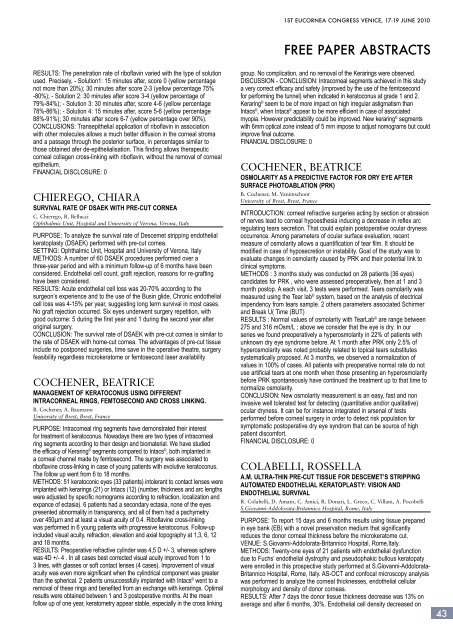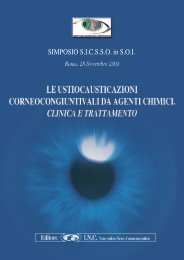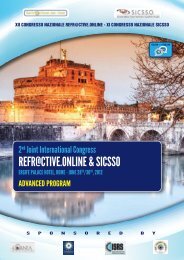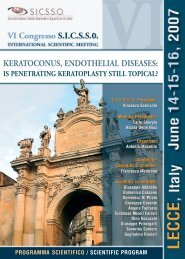1st EuCornea Congress
1st EuCornea Congress
1st EuCornea Congress
You also want an ePaper? Increase the reach of your titles
YUMPU automatically turns print PDFs into web optimized ePapers that Google loves.
<strong>1st</strong> <strong>EuCornea</strong> <strong>Congress</strong> venice, 17-19 june 2010<br />
FREE PAPER Abstracts<br />
RESULTS: The penetration rate of riboflavin varied with the type of solution<br />
used. Precisely, - Solution1: 15 minutes after, score 0 (yellow percentage<br />
not more than 20%); 30 minutes after score 2-3 (yellow percentage 75%<br />
-80%); - Solution 2: 30 minutes after score 3-4 (yellow percentage of<br />
79%-84%); - Solution 3: 30 minutes after, score 4-6 (yellow percentage<br />
78%-86%); - Solution 4: 15 minutes after, score 5-6 (yellow percentage<br />
88%-91%); 30 minutes after score 6-7 (yellow percentage over 90%).<br />
CONCLUSIONS: Transepithelial application of riboflavin in association<br />
with other molecules allows a much better diffusion in the corneal stroma<br />
and a passage through the posterior surface, in percentages similar to<br />
those obtained afer de-epithelialisation. This finding allows therapeutic<br />
corneal collagen cross-linking with riboflavin, without the removal of corneal<br />
epithelium.<br />
FINANCIAL DISCLOSURE: 0<br />
Chierego, Chiara<br />
Survival rate of DSAEK with pre-cut cornea<br />
C. Chierego, R. Bellucci<br />
Ophthalmic Unit, Hospital and University of Verona, Verona, Italy<br />
Purpose: To analyze the survival rate of Descemet stripping endothelial<br />
keratoplasty (DSAEK) performed with pre-cut cornea.<br />
Setting: Ophthalmic Unit, Hospital and University of Verona, Italy<br />
Methods: A number of 60 DSAEK procedures performed over a<br />
three-year period and with a minimum follow-up of 6 months have been<br />
considered. Endothelial cell count, graft rejection, reasons for re-grafting<br />
have been considered.<br />
Results: Acute endothelial cell loss was 20-70% according to the<br />
surgeon’s experience and to the use of the Busin glide. Chronic endothelial<br />
cell loss was 4-15% per year, suggesting long term survival in most cases.<br />
No graft rejection occurred. Six eyes underwent surgery repetition, with<br />
good outcome: 5 during the first year and 1 during the second year after<br />
original surgery.<br />
Conclusion: The survival rate of DSAEK with pre-cut cornea is similar to<br />
the rate of DSAEK with home-cut cornea. The advantages of pre-cut tissue<br />
include no postponed surgeries, time save in the operative theatre, surgery<br />
feasibility regardless microkeratome or femtosecond laser availability<br />
Cochener, Beatrice<br />
Management of keratoconus using different<br />
intracorneal rings, femtosecond and cross linking.<br />
B. Cochener, A. Baumann<br />
University of Brest, Brest, France<br />
Purpose: Intracorneal ring segments have demonstrated their interest<br />
for treatment of keratoconus. Nowadays there are two types of intracorneal<br />
ring segments according to their design and biomaterial. We have studied<br />
the efficacy of Keraring © segments compared to Intacs © , both implanted in<br />
a corneal channel made by femtosecond. The surgery was associated to<br />
riboflavine cross-linking in case of young patients with evolutive keratoconus.<br />
The follow up went from 6 to 18 months.<br />
Methods: 51 keratoconic eyes (33 patients) intolerant to contact lenses were<br />
implanted with kerarings (21) or Intacs (12) (number, thickness and arc lengths<br />
were adjusted by specific nomograms according to refraction, localization and<br />
expance of ectasia). 6 patients had a secondary ectasia, none of the eyes<br />
presented abnormality in transparency, and all of them had a pachymetry<br />
over 450µm and at least a visual acuity of 0.4. Riboflavine cross-linking<br />
was performed in 6 young patients with progressive keratoconus. Follow-up<br />
included visual acuity, refraction, elevation and axial topography at 1,3, 6, 12<br />
and 18 months.<br />
Results: Preoperative refractive cylinder was 4,5 D +/- 3, whereas sphere<br />
was 4D +/- 4 . In all cases best corrected visual acuity improved from 1 to<br />
3 lines, with glasses or soft contact lenses (4 cases). Improvement of visual<br />
acuity was even more significant when the cylindrical component was greater<br />
than the spherical. 2 patients unsuccessfully implanted with Intacs © went to a<br />
removal of these rings and benefited from an exchange with kerarings. Optimal<br />
results were obtained between 1 and 3 postoperative months. At the mean<br />
follow up of one year, keratometry appear stable, especially in the cross linking<br />
group. No complication, and no removal of the Kerarings were observed.<br />
Discussion - Conclusion: Intracorneal segments achieved in this study<br />
a very correct efficacy and safety (improved by the use of the femtosecond<br />
for performing the tunnel) when indicated in keratoconus at grade 1 and 2.<br />
Keraring © seem to be of more impact on high irregular astigmatism than<br />
Intacs © , when Intacs © appear to be more efficient in case of associated<br />
myopia. However predictability could be improved. New keraring © segments<br />
with 6mm optical zone instead of 5 mm impose to adjust nomograms but could<br />
improve final outcome.<br />
FINANCIAL DISCLOSURE: 0<br />
Cochener, Beatrice<br />
Osmolarity as a predictive factor for dry eye after<br />
surface photoablation (PRK)<br />
B. Cochener, M. Vanimschoot<br />
University of Brest, Brest, France<br />
Introduction: corneal refractive surgeries acting by section or abrasion<br />
of nerves lead to corneal hypoesthesia inducing a decrease in reflex arc<br />
regulating tears secretion. That could explain postoperative ocular dryness<br />
occurrence. Among parameters of ocular surface evaluation, recent<br />
measure of osmolarity allows a quantification of tear film. It should be<br />
modified in case of hyposecretion or instability. Goal of the study was to<br />
evaluate changes in osmolarity caused by PRK and their potential link to<br />
clinical symptoms.<br />
Methods : 3 months study was conducted on 28 patients (36 eyes)<br />
candidates for PRK , who were assessed preoperatively, then at 1 and 3<br />
month postop. A each visit, 3 tests were performed. Tears osmolarity was<br />
measured using the Tear lab © system, based on the analysis of electrical<br />
impendency from tears sample. 2 others parameters associated Schirmer<br />
and Break U( Time (BUT)<br />
Results : Normal values of osmolarity with TearLab © are range between<br />
275 and 316 mOsm/L ; above we consider that the eye is dry. In our<br />
series we found preoperatively a hyperosmolarity in 22% of patients with<br />
unknown dry eye syndrome before. At 1 month after PRK only 2.5% of<br />
hyperosmolarity was noted probably related to topical tears substitutes<br />
systematically proposed. At 3 months, we observed a normalization of<br />
values in 100% of cases. All patients with preoperative normal rate do not<br />
use artificial tears at one month when those presenting an hyperosmolarity<br />
before PRK spontaneously have continued the treatment up to that time to<br />
normalize osmolarity.<br />
Conclusion: New osmolarity measurement is an easy, fast and non<br />
invasive well tolerated test for detecting (quantitative and/or qualitative)<br />
ocular dryness. It can be for instance integrated in arsenal of tests<br />
performed before corneal surgery in order to detect risk population for<br />
symptomatic postoperative dry eye syndrom that can be source of high<br />
patient discomfort.<br />
FINANCIAL DISCLOSURE: 0<br />
Colabelli, Rossella<br />
A.M. Ultra-thin pre-cut tissue for Descemet’s stripping<br />
automated endothelial keratoplasty: Vision and<br />
endothelial survival<br />
R. Colabelli, D. Amato, C. Amici, R. Donati, L. Greco, C. Villani, A. Pocobelli<br />
S.Giovanni-Addolorata-Britannico Hospital, Rome, Italy<br />
Purpose: To report 15 days and 6 months results using tissue prepared<br />
in eye bank (EB) with a novel preservation medium that significantly<br />
reduces the donor corneal thickness before the microkeratome cut.<br />
Venue: S.Giovanni-Addolorata-Britannico Hospital, Rome,Italy.<br />
Methods: Twenty-one eyes of 21 patients with endothelial dysfunction<br />
due to Fuchs’ endothelial dystrophy and pseudophakic bullous keratopaty<br />
were enrolled in this prospective study performed at S.Giovanni-Addolorata-<br />
Britannico Hospital, Rome, Italy. AS-OCT and confocal microscopy analysis<br />
was performed to analyze the corneal thicknesses, endothelial cellular<br />
morphology and density of donor corneas.<br />
Results: After 7 days the donor tissue thickness decrease was 13% on<br />
average and after 6 months, 30%. Endothelial cell density decreased on<br />
43







